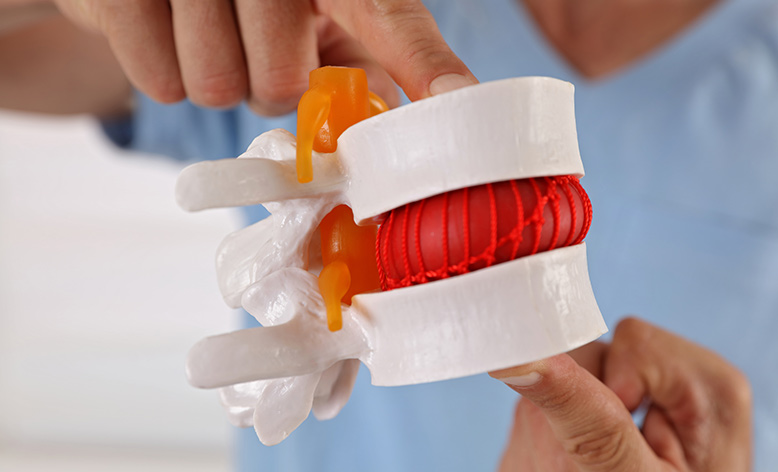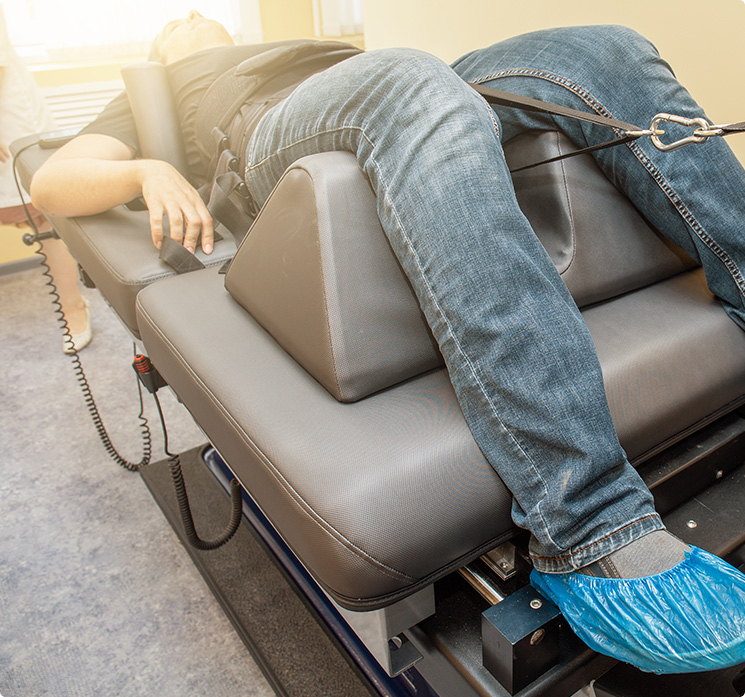Could you imagine going through life every day with near-debilitating, chronic back pain? Back pain is one of the most common ailments in America - it's estimated that 8% of all adults, or 16 million people, suffer from chronic back pain in the U.S. every year. If you've never experienced a back injury or pain, be thankful. Chronic back pain affects every aspect of a person's life, from participating in sports to limitations with everyday activities, like cooking dinner. In fact, many people with chronic back pain can't even make a reliable living and put food on the table. Almost 83 million workdays are lost every year due to choric back pain.

The inability to work and provide isn't just a physical issue - it can become an emotional one too. Many people suffering from chronic back pain also suffer from depression and anxiety. Unfortunately, in the past, chronic back pain sufferers wanting to avoid addictive medications and invasive surgeries had few viable relief options. However, if you're suffering from a chronic back issue like sciatica, a pinched nerve, or a bulging disc, pain relief may be closer than you think.
Modern chiropractic care and, more specifically, a spinal decompression chiropractor in Isle of Palms, SC, may be the long-term solution you need for chronic back pain.
A common misconception is that chiropractors only adjust your back and neck when, in fact, they treat the whole body with all-natural treatments. Here at Elite Healthcare, our doctors focus on your overall health, not just pain. We want to find and address the underlying causes of your symptoms. If you're unfamiliar with an integrative approach to medicine, this strategy may seem new. Our chiropractic care is less about putting a band-aid on the problem and more about finding a natural, long-term solution to your pain.
Fortunately, our experienced chiropractors provide the best in natural pain relief. Prescription and over-the-counter pain medications mask the symptoms you're experiencing versus getting to the cause of your pain. Pain is often the result of your spine being out of alignment, which leads to nerve issues. Once your spine is back in alignment, the nerves function correctly again.
Because our chiropractic center offers a combination of different therapies and non-surgical treatments, we provide a comprehensive approach to healing. Depending on the extent of your back problems, spinal decompression therapy may be the answer to your chronic pain problems.
Initially developed in 1985 by Dr. Allan Dyer, spinal decompression has been used by chiropractors for years. Unfortunately, spinal decompression is often passed over as a viable treatment, despite its numerous benefits.
In the past, patients suffering from chronic back pain issues like herniated discs were usually prescribed powerful medications. They were instructed to refrain from physical activities, referred to a physical therapist, and sent on their way. While physical therapy has an important role in back pain recovery, some back conditions need a more comprehensive treatment approach. For those patients, surgery seemed like the only option.
Today, patients with chronic back pain have many more options to consider. One of the most effective treatments for serious back pain is spinal decompression. This proven therapy, provided by Elite Healthcare, has been shown to significantly reduce pain and help patients live a normal, even active lifestyle once again.

Spinal decompression, also called Lumbar Cervical Decompression Therapy (LCD Therapy), is a very effective non-surgical solution to chronic back pain problems. If you're like most patients, your back pain is caused by disc issues related to your spine. This type of therapy uses computer technology and a spinal decompression machine in cityname, state, to stretch your spinal column slowly and gently, relieving abnormal pressure on the discs in your back, which sit in between your vertebrae.
This precise stretching action causes negative pressure to form inside the discs in your back, making them retract. With time, this negative pressure causes a reverse vacuum of sorts that actually draws your protruding discs into place. When pressure is removed from the disc segments in your spine, you experience much-needed pain relief.
The primary purpose of spinal decompression therapy is to provide you with immediate pain relief while creating a healthy environment to heal your spinal disc condition. Some of the most common conditions that spinal decompression therapy treats include:
This happens when spinal discs in your back are pushed outside of the spinal canal. When pushed outside of their usual space, these discs can put pressure on the nerves in your spine, resulting in localized pain and pain throughout your body. If a bulging disc is left untreated, it has a high chance of rupturing, which can necessitate surgery and longer recovery time.
Herniated discs are discs in your back that fracture or crack and leak fluid. The fluid or gel that leaks from a herniated disc may irritate the nerves in your back. When this happens, you may experience an intense burning sensation that shoots up and down your lower back and legs.
As you grow older, joints in your body, like your knees and hips, begin to wear away with time. The same thing can happen to the discs in your back. Often caused by heavy lifting or a family history of spine problems, degenerative discs are painful and can lead to serious situations. In advanced cases, bone spurs can form and affect the nerves of your spine.
When a herniated disc or bone spur begins to put pressure on the nerves in your back, it often causes sciatica. Sciatica is a common back problem that causes pain to radiate from your lower back down your legs via your sciatic nerve. Sometimes, this pain is only felt in one of your legs.
This condition is similar to arthritis of your spine, where the cartilage inside your facet joint breaks down and becomes inflamed. The result is often intense neck and back pain. It's most often caused by degenerative changes in the joints located between the bones of your spine.
This painful condition manifests when the space in your backbone is too small. When this happens, pressure impacts your spinal cord and the nerves that travel through it. Like other conditions treated by a spinal decompression therapy cityname, state, stenosis is caused by wear-and-tear in your back, which forms arthritis.
This term is often used to classify a range of back problems, most often caused by a pinched nerve root in your spinal column. This pinched nerve root may occur in different locations down your spine, like the lumbar or thoracic areas. Usually caused by a narrowing of the space where your nerve root leaves the spine, symptoms of this condition include pain, tingling, numbness, and weakness.
If you're looking for a safe way to relieve your chronic back pain, spinal decompression should be on your list of treatments to consider. This painless procedure is backed by research showing higher success rates in many patients when compared to spinal surgery. Unlike many medications, spinal decompression from Elite Healthcare Physical Medicine is designed to correct the condition you're facing while also minimizing costs and eliminating recovery and downtime.
Some of the most popular reasons why patients choose spinal decompression over surgery and other treatments include:
Invasive procedures, like back surgeries, often leave the patient racked with pain, long recovery times, and complications. Sometimes, the surgery doesn't work as intended, leaving the patient responsible for a therapy that didn't work correctly. As a non-invasive treatment, spinal decompression therapy can treat back and neck pain without needles, incisions, or harmful manipulations of the spine.

Getting back pain relief from surgery is far from guaranteed. However, because spinal decompression targets the underlying causes of your back pain, it's a much more effective long-term treatment. Spinal decompression is not a quick fix. When coupled with positive lifestyle changes like losing weight, you can maximize the pain-relieving benefits of spinal decompression.

Surgery of the back and spine requires the patient to be bedridden and uncomfortable for days and even weeks. Recovering from back surgery is no easy feat and often requires strong pain medications to help. Sometimes, back surgeries don't go as planned, causing complications and worse scenarios. Spinal decompression, on the other hand, is very effective and doesn't require much recovery time at all. Once your spinal decompression session is over, you'll probably be able to drive yourself home from our office.

One of the least talked about issues with back pain medications is that they only treat the pain, not the underlying causes. For many patients, relying on meds to relieve back pain fosters dependency on pain pills. Pain pill addiction is a very serious issue in the U.S., often leading patients down a dark path. With spinal decompression, you won't have to worry about taking pills for pain relief. That's because the root causes of your back pain are addressed, not just the symptoms.

If you were to look at the cost of surgery and subsequent years of prescription medication, you might be shocked. When compared to spinal decompression, surgery is a much more expensive treatment to consider. You've got to take the cost of surgery into account, but also the fact that you'll be forced to take time off work. By choosing spinal decompression therapy, you're choosing a safe, non-surgical treatment that doesn't require any time off work.

Spinal decompression relieves pressure on disrupted discs, causing them to retract back into place. This revolutionary treatment also lets oxygen, fluids, and nutrients re-enter your spinal discs, which provides additional healing.
 (843) 936-6238
(843) 936-6238

By now, you probably have a better idea of how spinal decompression can help rid your life of back pain. But spinal decompression treatment does more than help with bulging discs, herniated discs, arthritis, and more. It has also been shown to provide patients with important quality-of-life benefits.

As mentioned above, harsh surgeries leave you bedridden and unable to work for long periods of time. Spinal decompression allows you to jump right back into the workforce, so you can continue providing for your family. Plus, reducing your back pain naturally increases your mobility since you won't be stressing about hurting yourself while moving. Instead, you'll be living in the moment.
One of the worst symptoms affecting people with back pain is the inability to sleep well. Sleeping with back pain can be horrible, causing you to toss and turn to find a comfortable spot. As soon as you find one and get settled, your back starts to hurt again. It's a vicious cycle, but adjusting your spine and relieving pressure with spinal decompression will help you get a good night's rest.
Did you know that when your spine is decompressed, it helps fluids circulate throughout your body? These fluids actually flush your lymphatic system, which helps support your overall immune system. Better circulation also benefits your brain and can help boost concentration and memory. The improved circulation from spinal decompression may also distribute oxygen and nutrients to your skin, creating a multi-benefit effect.
We are happy to answer your questions, and help you find the services you need. Please message us to get started.
At Elite Healthcare Physical Medicine, we practice an integrated approach to pain relief and chiropractic care. Our goal is to restore your spine to its proper alignment, which speeds up your recovery time and prevents additional injuries. If chronic back pain has taken over your life, it's time to visit our chiropractic office for a thorough evaluation.
Ask yourself this: Have you been suffering from headaches and sleepless nights due to muscle strain? Is your ability to work and put food on the table compromised due to a pinched nerve? No amount of over-the-counter pain medication can provide a long-term fix for such an issue. Thankfully, our chiropractors have years of experience providing relief to patients just like yourself.
After a comprehensive exam, our doctor will create an individualized treatment plan tailored to your body. That way, we can address the full scope of your symptoms by correcting any root causes of your back pain.
From minor chiropractic adjustments to spinal decompression treatment, we'll find the solution that your back and body need to heal correctly. If you're ready to get back on the road to better health, we're here to help every step of the way. Contact our Elite Healthcare Physical Medicine today to get started.
 (843) 936-6238
(843) 936-6238
ISLE OF PALMS, S.C. (WCBD) — The ongoing conflict between the South Carolina Dept. of Health and Environmental Control (DHEC) and a homeowner on the Isle of Palms has now gone to court.After storms in August and December 2023 led to significant beach erosion, Rom Reddy, an oceanfront property owner, took matters into his own hands by building a wall to prot...
ISLE OF PALMS, S.C. (WCBD) — The ongoing conflict between the South Carolina Dept. of Health and Environmental Control (DHEC) and a homeowner on the Isle of Palms has now gone to court.
After storms in August and December 2023 led to significant beach erosion, Rom Reddy, an oceanfront property owner, took matters into his own hands by building a wall to protect his property near Breach Inlet from beach erosion.
However, earlier this month, DHEC officials told News 2 that anything built on critical areas of the coast, like beaches, needs a permit. They added that after investigating Reddy’s wall, they issued Reddy and the contractor cease and desist directives because it was an “unauthorized structure.”
However, DHEC officials said Reddy’s work on the wall continued even after the directives were issued.
Now, attorneys for DHEC have taken the battle to court, filing a temporary restraining order (TRO) and petition for injunctive relief in South Carolina Administrative Law Court.
“Due to the Respondents’ egregious disregard of OCRM’s Notice to Comply and the two Cease and Desist Directives, the Department has no adequate remedy at law other than to seek judicial intervention to compel the Respondents to immediately cease their unauthorized actions in the critical area,” the court filing reads.
This week, Reddy’s lawyers responded to the agency’s court filings requesting that the judge deny the motion for a TRO and petition for injunctive relief.
Reddy’s lawyers argue that his wall is not located in a critical area and that DHEC lacks the subject matter jurisdiction to issue the cease and desist in the first place. “In issuing these directives, Petitioner [DHEC] is unilaterally and unfairly extending its jurisdiction to convert private property into a public beach,” the court filing reads.
They also say that the cease and desist is a moot point because no ongoing work was being done when DHEC filed the TRO. “Petitioner [DHEC] seeks a TRO and injunctive relief to allegedly stop Respondents from ‘continuing to install a hard erosion control structure adjacent'” to the Property. As of the date of this filing, no ongoing work is being done on the Property: therefore, Petitioner’s cease-and-desist directives are moot,” they wrote.
Reddy’s attorneys also filed a countersuit against DHEC and the city of Isle of Palms with several claims, including that they violated Reddy’s constitutional rights. “DHEC has engaged in actions and inactions that have converted Respondents· private property into a public beach without justcompensation in violation of the South Carolina Constitution and the United States Constitution,” they argue.
Reddy’s attorneys also claim that DHEC and Isle of Palms leaders failed to maintain the beach near his property. In the court filing, they write, “DHEC also fails to note that prior to the Idalia storm damage, in June of 2023, Respondents sent various letters and notices of the vulnerability of the Isle of Palms properties due to improper beach renourishment by Isle of Palms and Petitioner [DHEC].”
Reddy’s lawyers also requested the case be moved to circuit court for a jury trial.
News 2 reached out to Reddy for comment about the court filings. In a statement, he said “state jurisdiction over private property is set by the SC General Assembly and last approved in 2018. DHEC, a state agency has illegally taken upon itself the task of claiming jurisdiction property by property based on a single storm. This provides Government unlimited and varying jurisdiction over private land. This is unconstitutional and will not stand”.
When News 2 asked DHEC for comment, an agency spokesperson responded “DHEC doesn’t comment on pending litigation. DHEC’s Petition For Injunctive Relief and Motion for TRO and Preliminary Injunction explain in detail the Department’s position.”
The Chief Administrative Law Judge has set a hearing date on April 18 for DHEC’s motions. Both Reddy and DHEC will present their evidence at this time.
Editor’s note: This story has been updated to include additional information from the city, including the fact that IOP city does not set prices for the new park area.—ISLE OF PALMS, S.C. (WCBD) – Construction is underway on a new Isle of Palms waterfront space that will include a pier and other amenities.Chaundra Yudchenko, who serves as the city’s public relations and tourism coordinator, said the Isle of Palms Public Dock Renovation Project will include a new 16-foot-wide pier with swings and b...
Editor’s note: This story has been updated to include additional information from the city, including the fact that IOP city does not set prices for the new park area.
—
ISLE OF PALMS, S.C. (WCBD) – Construction is underway on a new Isle of Palms waterfront space that will include a pier and other amenities.
Chaundra Yudchenko, who serves as the city’s public relations and tourism coordinator, said the Isle of Palms Public Dock Renovation Project will include a new 16-foot-wide pier with swings and benches.
The project also includes a floating dock with American Disabilities Act (ADA) compliant kayak and stand-up paddleboard launching.
Yudchenko said the public dock is not intended to be used for boat mooring; it will be available to the public for recreational use and passive water activities.
Construction of the public dock is set to begin in March with completion in May.
It’s all part of a 2020 vote by Isle of Palms City Council to improve the island’s marina area.
And while some are excited to have a new area to spend time with their family, others are concerned about potential costs.
“It’ll be nice to have something to bring the grandchildren over to and stuff like that- so, it’ll be nice,” said part-time resident, Dale Johns.
The project is an investment city council member Blair Hahn said was expensive but well worth it.
“The city has gone to great expense to redo the dock and we’re going to have a little green space,” Hahn said.
However, a visit to the park could cost more for non-residents. The plan is to charge visitors for parking and to launch a boat from the public dock. The cost to park is $3.50 per foot of the trailer plus a utility fee per day.
The private marina operators set fees for the new park area – they are not set by the city.
One non-resident who wanted to stay anonymous said many people are upset about this part of the plan. “The city is granting its residents special parking privileges and charging nonresidents exorbitant fees, all while calling this a “public dock.”
Hahn says fees for accessing public parks are nothing new in Charleston.
“It’s no different than Charleston County Park. They charge $20 a car to park on the island so unfortunately, that’s just a reality,” Hahn said.
The nonresident went on to say not everyone will be able to pay the fees.
“The city of Isle of Palms needs to treat residents and nonresidents the same at its “Public park” and charge everyone a fair amount, or allow free parking for everyone,” they said.
The city, according to Yudchenko, has not discussed implementing any feeds for the use of the public dock.
“Marina docks, boat launch fees, and The Outpost marina store are managed by Coastal Marinas, which is a tenant of the city. Fees for boat launching, dockage, and storage are determined by the marina tenant,” said Yudchenko.
Despite the concern, Hahn believes the park will still serve as a popular meeting spot for locals and visitors.
“We are doing everything we can to be resident-friendly and visitor-friendly and to bring people to Isle of Palms, but there’s always a cost to everything you do,” Hahn said.
Additionally, Yudchenko said the city is working with the marina restaurant, Islander 71, on a new parking layout to “increase the number and efficiency of parking spaces available to residents, visitors, and restaurant customers.”
The project is expected to be completed by May of this year.
The Isle of Palms is the latest beachfront area now dealing with an uptick in coyote sightings and attacks. (WCIV)ISLE OF PALMS, S.C. (WCIV) — The Isle of Palms is the latest beachfront area now dealing with an uptick in coyote sightings and attacks.As a result, the city is taking action including more signage and setting out traps.John Hendricks likes to take his dog Zoe on early morning walks on the beach at Isle Palms. He's had his share of run-ins with coyotes. The most recent ended with Zoe being attacked....
The Isle of Palms is the latest beachfront area now dealing with an uptick in coyote sightings and attacks. (WCIV)
ISLE OF PALMS, S.C. (WCIV) — The Isle of Palms is the latest beachfront area now dealing with an uptick in coyote sightings and attacks.
As a result, the city is taking action including more signage and setting out traps.
John Hendricks likes to take his dog Zoe on early morning walks on the beach at Isle Palms. He's had his share of run-ins with coyotes. The most recent ended with Zoe being attacked.
"She definitely saw them. She chased after them," Hendricks said. "She realized that she got a little too deep. We left, got her stitches, and had to put her on quarantine for 45 days."
Zoe is now recovering, but the coyote attack has left her a little skittish when she heads to the beach.
"I took her down the same path. At first, she's like, 'Oh, right, we're at the beach.' But then, when she realized what path she was on, she's like, 'I'm not going down that path.' We turned around and went back to the car. Today, I took her down a different path and she was a little tentative," said Hendricks
Now this most recent attack has changed Hendricks' mind on trying to co-exist with coyotes.
"Before, I was much more live and let live, and we gotta learn how to get along. But after this event, I'm like, you try to take my life, so now I'm willing to take your life," Hendricks said.
Dr. Marian Shuler Holladay treated Zoe.
"They engage the dog almost in a playful manner, and then when the dog goes over, there seem to be others waiting. All of the animals I've seen attacked – all of the bite marks – seem to be in the hind end and the hind haunches, in the flanks, and in the abdomen," Holladay said.
Even a minor attack can come with a heavy price tag.
"Sometimes they need repairs. Sometimes they need drains put in and sutures to close the lacerations. Sometimes it can be anywhere between $500 to $1,500 or more per incident," Holladay said.
Isle of Palms has increased signage on the beaches and is working with a trapper to set traps. They are also holding a public safety meeting at the Isle of Palms City Hall, next Tuesday from 9-10 AM. Hendricks believes the city is doing what it can to keep the beach safe.
"They're not doing knee-jerk reaction. I think they're gathering data. I think they're doing what's appropriate."
ISLE OF PALMS, S.C. (WCBD)- Parking on the Isle of Palms continues to be a contentious topic.Some saying that a parking plan approved by the South Carolina Department of Transportation in 2015 which established resident-only parking zones needs to be revoked.The parking plan that was approved in 2015 eliminated a significant number of free parking.The approval was unpopular among the Charleston Beach Foundation, a group that advocates for more public access to the beaches, when it was first approved.Now, this plan...
ISLE OF PALMS, S.C. (WCBD)- Parking on the Isle of Palms continues to be a contentious topic.
Some saying that a parking plan approved by the South Carolina Department of Transportation in 2015 which established resident-only parking zones needs to be revoked.
The parking plan that was approved in 2015 eliminated a significant number of free parking.
The approval was unpopular among the Charleston Beach Foundation, a group that advocates for more public access to the beaches, when it was first approved.
Now, this plan is now receiving renewed pushback.
“For Isle of Palms to eliminate parking in those right of ways is wrong to begin with and probably unconstitutional,” Parking advocate, Michael Barnett said.
Barnett, who started a petition over beach restrictions in the Lowcountry, says this parking issue has come up again after Isle of Palms voted to deny the short-term rental cap.
Barnett said, “The Isle of Palms is allowing short term rentals throughout the island, essentially making the residential only districts, commercial districts.”
Monday morning, Myra Jones with the Charleston Beach Foundation sent the City of Isle of Palms a letter, asking for the plan to be revoked, arguing IOP no longer has legitimate “residential” areas since the resolution to cap short-term rentals on the island failed.
“So, the SCDOT needs to now go back, review the 2015 parking plan, request that the Isle of Palms redo the parking plan, and they need to give back all residential only parking, they need to give back all 3,000 parking spaces that they took in 2015,” Barnett said.
Isle of Palms city council members are fighting back.
Councilman Blair Hahn providing a statement reading, “In response to Myra Jones’ letter to City council dated November 27th, 2023, full council has not had an opportunity to discuss. However, Ms. Jones’ continued attempts to characterize the Isle of Palms as not resident friendly, not tourism friendly, not visitor friendly is nonsensical. Isle of Palms provides 8 times more public beach parking than is required by the SC Beach Front Management Act and more public parking per mile of beach than any other community in South Carolina.
Ms. Jones has previously taken her grievances to the South Carolina Courts and has lost. In my opinion, this is nothing more than another attempt of Ms. Jones to ignore the laws of the State and attempt to force her will on Charleston beach communities.
IOP city council members say they plan to discuss this more in future council meetings.
ISLE OF PALMS, S.C. (WCSC) - The Isle of Palms City Council approved an emergency ordinance on erosion control Tuesday evening.The ordinance passed with a 7-2 vote that will allow homeowners to build seawalls or revetments along their personal property lines. This would apply to 100-914 Ocean Boulevard, a 1.3-mile-long stretch of road and Breach Inlet.The council discussed two options. Option one creates a setback where homeowners must build their structure within a selected 35-foot window. The second option leaves it up to the...
ISLE OF PALMS, S.C. (WCSC) - The Isle of Palms City Council approved an emergency ordinance on erosion control Tuesday evening.
The ordinance passed with a 7-2 vote that will allow homeowners to build seawalls or revetments along their personal property lines. This would apply to 100-914 Ocean Boulevard, a 1.3-mile-long stretch of road and Breach Inlet.
The council discussed two options. Option one creates a setback where homeowners must build their structure within a selected 35-foot window. The second option leaves it up to the South Carolina Department of Health and Environmental Control to decide where they can or cannot be built.
The council voted on option one, with an amendment to where the seawalls can be built. Instead of a 35-foot window, the council changed it to 20-feet.
“Sometimes it’s two readings, sometimes it’s three, but tonight it’s an emergency one,” Isle of Palms Mayor Phillip Pounds says. “It’s been one thing after the other for the last six or seven months so the city has been in an emergency basis. This is kind of the next step.”
Many beachfront properties are still feeling the impacts of Hurricane Idalia, which tore away much of the beach access and caused severe erosion damage. The storm surges and coastal flooding that followed added to the problem.
If the council votes yes on the ordinance, homeowners would be able to build a revetment, which is a sloping structure, or a seawall, a vertical structure, to battle erosion damage. These entities would be the sole responsibility for property owners and must comply with material or construction requirements.
Seawalls would need to be a maximum height of 10 feet and cannot be made visible. The structures cannot be made of recycled concrete or materials and must be designed by engineers who can confirm it would not have a negative impact.
Coastal Conservation League Director of Land, Water and Wildlife Riley Egger called the ordinance a “misstep.” She asked the city to consider alternatives like renourishment instead.
“Restore dune systems that provide for wildlife habitat, protect private property owners and provide for public access,” Egger says. “Seawalls provide a false sense of security.”
Pounds says the Army Corp of Engineers is set to begin a project within the next month that would rebuild the dune back.
“The sandbags and scraping has really just been a band-aid,” Pounds says. “It was really just to get over the hump of this large project that’s coming.”
The ordinance also requires neighbors and the South Carolina Department of Health and Environmental Control Ocean and Coastal Resource Management be notified before construction begins. The department is currently the only entity that can authorize the changing of critical areas.
The department prohibits the use of heavy machinery, equipment or materials within the critical area for installing a seawall or revetment. Sand must be from an upland source.
If a seawall or revetment is not taken care of properly, the city or its coastal engineer can remove it.
City ordinances allow emergency action for issues believed to affect life, health, safety and property. If the ordinance passes, it will be effective immediately and be active for 60 days.
Copyright 2024 WCSC. All rights reserved.
